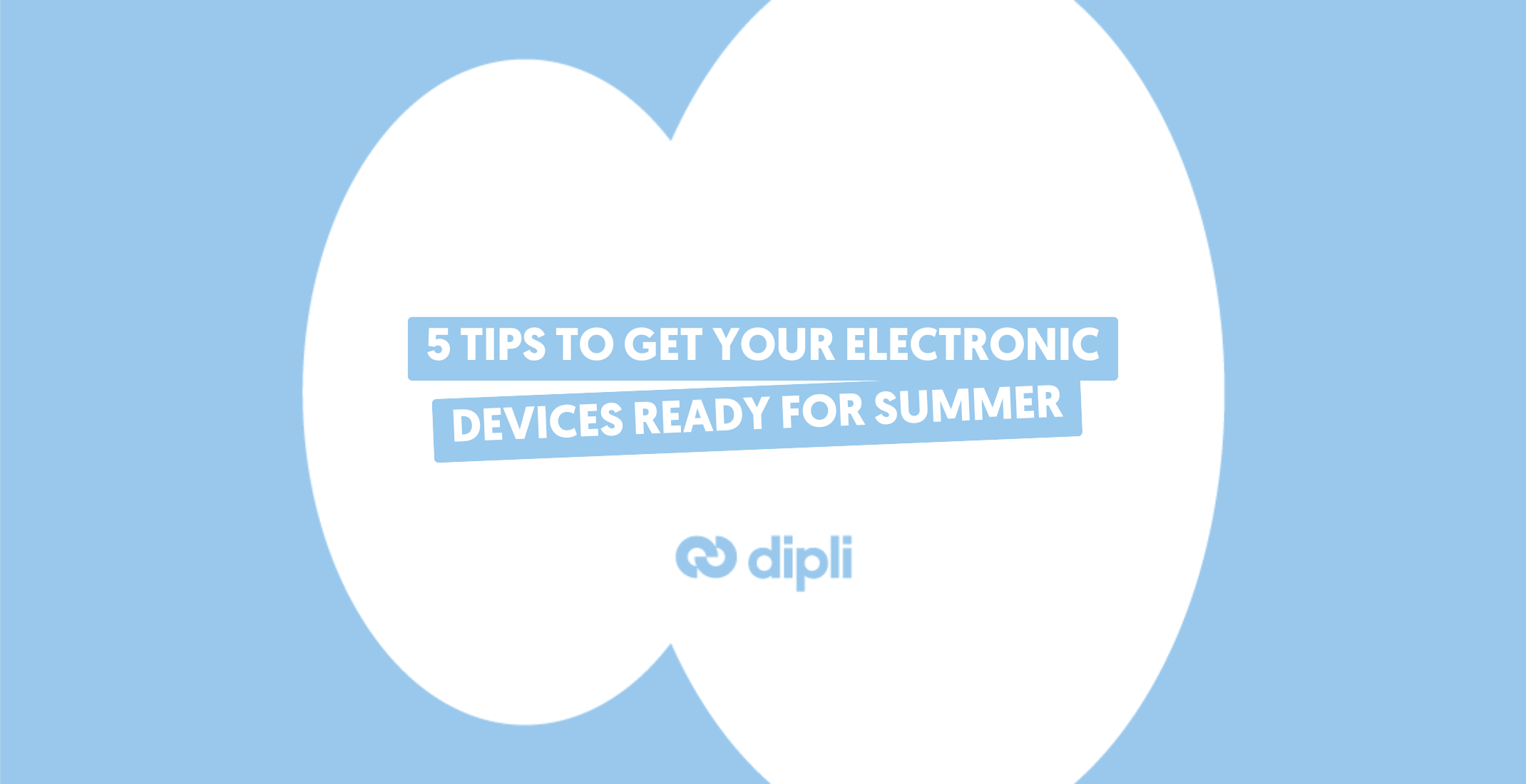Get your electronics summer-ready: 5 essential tips
24/07/2025
0 comments

With the arrival of summer, your professional electronic equipment and refurbished devices are exposed to specific stresses: heat, humidity, intensive use... To preserve their performance, prevent breakdowns during this season, and ensure your devices operate smoothly, here are 5 essential tips to implement in your organisation right away.
These tips will help guarantee the reliability of your devices, whether you're in the office or on the go, so you can maintain your company’s productivity.
1. Prevent your electronic devices from overheating
Professional electronic devices must be kept at optimal temperatures to ensure long-term performance and reliability, especially when they play a critical role in your company’s operations.
It's essential to avoid excessive heat caused by direct sunlight or heavy use of power-intensive features (such as GPS, camera, or mobile data), which can lead to damaging overheating.
🧊 Why is overheating an issue?
- Accelerated battery aging: high temperatures (above 35 °C) speed up the chemical degradation of lithium-ion batteries, shortening their lifespan and reducing battery autonomy.
- Processor speed reduction: when exposed to high heat, the processor and other internal components slow down to limit heat generation. This safety mechanism helps prevent damage, but significantly reduces device responsiveness.
- Risk of hardware failure: prolonged heat exposure can damage sensitive components such as the screen or camera, potentially leading to costly repairs.
- Data loss risk: if extreme heat causes complete device failure, there is a real risk of irreversible data loss.
💡 What simple tips can help avoid these issues?
- Don’t leave your devices in direct sunlight.
- Clean vents and fans regularly: dust buildup reduces cooling efficiency.
- Remove thick protective cases while charging to improve airflow and reduce heat accumulation.
- Enable Power-saving mode when needed: it reduces background tasks and screen brightness, lowering heat generation.
- Install software updates: they may include thermal management improvements.
- Pay attention to temperature warnings: if you see one or notice performance drops, turn off the device and let it cool in a shaded area (not in the fridge).
🖥️ What should professionals do for heavier infrastructures (servers and routers)?
- Advanced liquid cooling: ensure your data centers are well ventilated and equipped with appropriate cooling systems. These technologies are especially effective in maintaining stable temperatures and preventing overheating.
- Regular IT infrastructure checks and maintenance: make sure ventilation grilles are not obstructed, remove dust regularly, and perform software updates to optimize thermal management.
In summary: keeping your equipment at a controlled temperature is essential for ensuring the longevity, reliability, and performance of your professional devices while also reducing costs related to repairs and operational downtime.
2. Protect your devices from outdoor conditions
Professional electronic devices are vulnerable to weather conditions such as rain, humidity, dust, and sun exposure. To preserve their reliability and longevity, adequate protection for outdoor environments is essential.
🌧 Why can bad weather damage your devices?
- Rain and humidity: water can cause short circuits and permanently damage electronic circuits.
- Dust and particles: these can clog device ventilation systems, leading to overheating, malfunctions, and data loss.
- Temperature fluctuations: hot-cold cycles create internal condensation, which can lead to corrosion and system failures.
- UV rays and heat: these can damage plastic materials and accelerate the wear of external components.
🛠️ How to prevent such incidents?
- Choose durable cases: if your operations require outdoor device usage, invest in specialized cases that offer protection against water, dust, and UV exposure.
- Use waterproof soft phone cases: these provide optimal protection against rain, dust, and impact, while still allowing full device functionality.
- Clean regularly and install filters: remove dust and debris using compressed air or a microfiber cloth, and install filters to prevent the buildup of impurities.
By proactively protecting your devices from outdoor conditions, you will ensure the performance of your IT equipment, complementing the strategies used to prevent overheating.
3. Implement data backup policies

Your company’s data is worth its weight in gold. To protect your valuable information and ensure uninterrupted business continuity, it is essential to implement robust data backup policies.
📈 Why is a backup policy indispensable?
- Continuity and compliance: regularly backing up critical data helps maintain operations and meet regulatory requirements (such as GDPR, etc.).
- Resilience against cyberattacks: in the event of an attack, having reliable and isolated backups enables rapid recovery.
- Prevention of operational disruptions that could affect productivity.
- Protection of your company’s reputation by minimizing data loss incidents.
🙌 How can you prevent such scenarios?
- Identify critical data: focus on the files that are essential and must not be lost (customer data, accounting, contracts, etc.).
- Back up your data regularly: perform backups at regular intervals based on the importance of the data.
- Use off-site backups: store backups outside your premises to protect against potential disasters. You can also use external drives or cloud solutions.
- Encrypt your backups: secure them with a strong password or encryption software to prevent them from being compromised as well.
- Raise staff awareness: make sure your teams are informed about your backup policy so that everyone follows the guidelines across the company.
A well-designed backup strategy brings numerous benefits: it protects your critical information from unexpected loss and builds trust with clients and partners by demonstrating your commitment to data security. In short, it supports the long-term sustainability of your business.
4. Plan preventive maintenance to avoid breakdowns
Regular maintenance of your professional devices helps prevent unpleasant surprises. By implementing a consistent preventive maintenance schedule, you reduce the risk of breakdowns, improve performance, and cut down on unexpected expenses.
🚧 How to implement preventive maintenance?
- Set a regular schedule: plan maintenance checks monthly or quarterly, depending on how intensively your equipment is used.
- Inspect critical points: check the temperature, ventilation, battery condition, cables, etc., for your IT systems and key equipment. The goal is to identify and fix issues before they escalate.
- Clean the devices: remove dust, replace filters, and change worn parts to prevent overheating.
- Run software updates: ensure all systems and applications are updated with the latest versions.
- Document all interventions: keep a maintenance log to monitor the condition of each device and schedule future actions accordingly.
Effective maintenance of your electronic equipment significantly extends its lifespan and optimizes your return on investment. It also ensures more stable and reliable performance, increasing customer satisfaction and enhancing your reputation in the B2B market.
5. Raise awareness among your team about best practices
Your equipment may be well maintained, but without team awareness, the risks remain high. Training and involving your employees in best practices helps prevent human errors that can lead to device failures or data loss.
💼 How to raise awareness simply and effectively among your team?
- Promote regular backups: educate every team member on how to back up their important files using the method your organization has chosen.
- Explain the risks of overheating: help them understand why it's essential to avoid excessive heat and how to respond if a device gets too hot.
- Standardize maintenance procedures: share simple checklists so everyone can regularly check the condition of their equipment.
- Keep them informed of policy updates: if your internal practices evolve, communicate clearly with your teams so they can implement the necessary changes and stay aligned with your requirements.
An informed and engaged team is your best defense against everyday incidents. Moreover, better understanding of quality, safety, and ethical standards fosters a harmonious and productive work environment, where everyone knows which actions are appropriate and beneficial for the company.
Implementing our 5 tips encourages continuous improvement and the adoption of more efficient processes to enhance overall business performance through a protected, secure, and properly maintained IT fleet.
By following this advice, you will be fully prepared to handle summer challenges and ensure a successful back-to-business season!



